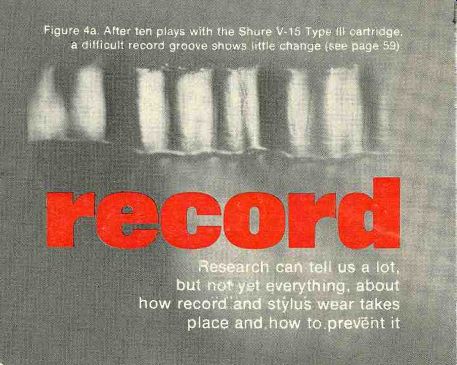
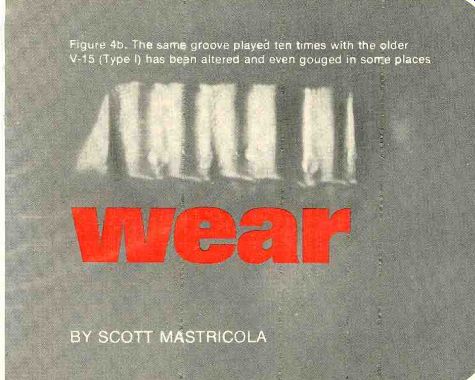
above: Figure 4a. After ten plays with the Shure V-15 Type III cartridge, a difficult record groove shows little change. Figure 4b. The same groove played ten times with the older V-15 (Type II) has bean altered and even gouged in some places.
BY SCOTT MASTRICOLA
Research can tell us a lot, but not yet everything, about how record and stylus wear takes place and how to prevent it.
WEAR, whether of diamond stylus or of vinyl disc, is very likely something that most of us think of, at least fleetingly, every time we put a valued recording on our turntables. Dirt, dust, finger oils, stylus-tip geometry, stylus-assembly de sign, anti-skating, and even the plastic composition of the disc itself can be seen to play their various roles. Today's best record-playing systems permit unprecedentedly low tracking forces, but wear of the record groove and stylus tip are nonetheless still with us, along with their resulting noise, loss of crispness and clarity, and general distortions of the sound signal.
Though it might seem that the root causes of record and stylus wear should be rather easy to pin down if not entirely eliminate, many extensive studies of the stylus/groove relationship have failed to yield a complete under standing of the wear process and the factors that contribute to it. We do know this much, however: wear is a process acting mutually on the stylus tip and the record; it begins with the very first play and continues with every play thereafter. The rate of wear may change as the condition of tip or record changes, but the process of wear is al ways present.
Causes of Wear
Friction is clearly one basic cause of wear. When any two surfaces rub together, a frictional force is present between them, and the surfaces of the stylus tip and the record-groove wall are no exception. Since neither of these two surfaces is perfectly smooth, microscopic particles of both tip and record can be dislodged when the stylus moves along the groove walls. Some of this debris may be temporarily trapped between the tip and the groove wall, and other particles may become em bedded in the vinyl and contribute a bit more to the abrasive action. The heat generated by the friction also probably acts to accelerate the wear rate. One suggested way to reduce both friction and heat is to play records with a liquid or other coating (there are several products on the market designed for this). A liquid coating may act as a friction-reducing lubricant and also absorb part of the heat that otherwise would have gone into the vinyl. "Wet" playing may have some merit if the coating doesn't leave a stylus- or groove-clogging residue on the record or accelerate the deterioration of the vinyl. The new "dry" lubrication technique may also help, but more data are needed on all these questions.
Another cause of wear (it of course has a greater effect on the record than on the stylus) is permanent (as opposed to "elastic" or temporary) deformation of the vinyl groove, At a 1-gram tracking force, the average pressure on the groove wall in the area of stylus con tact has been estimated at 30,000 to 66,000 pounds per square inch. The vinyl deforms under this pressure, and it does not spring back into its original shape completely. Even on the very first play, therefore, there is going to be some permanent modification of the record-groove wall. With additional plays, the groove wall cracks and material is torn away.
Both aspects of the wear process friction and deformation-occur simultaneously and continuously at every point along the groove wall contacted by the stylus tip. Anything affects wear that either directly or indirectly affects the tip friction of the stylus or the de formation of the record groove wall.
Let us examine these potentially destructive-factors one by one:
Disc Material: The various blends of vinyl compounds and additives used to manufacture records have different physical properties. In addition to wear resistance, the raw material must have properties that fulfill requirements having to do with processing, warpage, time and temperature stability, and, of course, economy. Raw material of good quality does not by itself assure a favorable wear rate; it must be properly processed at the molding (pressing) stage. Molding temperatures, the timing of the pressing cycle, the handling and the cleanliness of the record mold or "stamper"-all these must be under careful control.
Stylus Tip: Several features of the stylus tip can influence not only the length of its working life but the dam age it can do over that time to the records it plays. Diamond stylus tips are manufactured, first of all, in a variety of basic shapes. Probably the most common is the "spherical" tip. Other shapes are the "biradial" (or "elliptical") and the more recently introduced "long-contact" designs (Shibata, Pramanik, Hyperbolic, etc.). Each presents a differently shaped surface to the groove wall, and therefore each probably has its unique influence on wear rates. One design hypothesis has it that a tip with a large groove-contacting surface spreads the force acting on the wall over a greater area, thereby reducing the force per unit of surface area on the groove wall. But, although pressure is lower, friction may be higher and the groove area affected greater, somewhat nullifying the possible benefits. In addition, other factors such as the dynamic characteristics of a given stylus assembly can easily offset any advantages that result from having a larger contact area.
Other properties of the tip may also influence wear-the degree of polish on the tip surface in the groove-contact region, for example. A rough, coarse surface increases friction and probably the rate of wear on both tip and record.
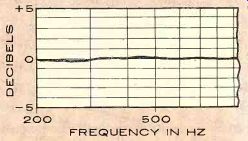
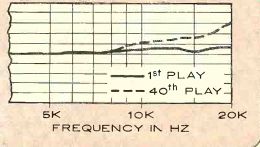
----- Figure 1. After forty plays of the same test record, the
cartridge under examination shows an apparent rise in frequency response by
over 2 dB at 20,000 Hz. But what is really responsible is groove-wall damage.
occurring at high frequencies.
Tips in high-quality cartridges are made of highly polished natural diamond, and they last at least two to four times as long as sapphire tips. But there are degrees of excellence even among diamonds, and microscopic impurities and imperfections in the crystal structure can affect tip life significantly.
Tracking Force: It is perhaps self-evident that tracking force is one of the more important factors affecting wear rates. Higher tracking forces stress the groove walls more, increasing the amount of permanent groove deformation. And since friction is related to tracking force, higher forces tend to accelerate tip and record wear.
Signal and Stylus: Not quite as evident is the fact that the recorded signal and the manner in which the stylus responds to that signal (the dynamic characteristics of the stylus assembly) have a significant effect on wear. The recorded signal varies over a wide range of frequencies and amplitudes, and to reproduce this signal accurately the stylus must be capable of following the very complex path presented by the modulated groove. In less than ideal circumstances the stylus may not be able to accelerate quickly enough to follow the rapidly changing high-frequency modulations, while at low frequencies it may not have sufficient compliance to cope with large amplitudes or high velocities. At these difficult points along the signal path the vinyl can be severely deformed if the stylus misbehaves, and the stylus tip it self may be subjected to significantly higher frictional forces.
As the stylus proceeds along the groove, the force acting on the tip and the groove wall is continuously changing. Note that this "instantaneous" force must be distinguished from the stylus tracking force; the instantaneous force, which is related to the signal, reaches values both higher and lower than the stylus tracking force. The combination of good tracking ability and low tracking force minimizes the contribution of the instantaneous force and therefore the rate of wear. Some times the stylus mistracks-that is, it loses contact with the groove walls be cause of its inability to follow the difficult twists and turns of the signal path.
Mistracking can frequently be eliminated by increasing the tracking force, a measure that may actually be the lesser of two evils, since the damage the record sustains when the tip bounces along the groove wall is likely to be greater than that resulting from the wear higher tracking force brings. It follows from this that the better the tracking ability of a cartridge at a given tracking force, the less the groove dam age. Considering the influence of mis tracking and similar factors, it should be clear that tip geometry alone does not guarantee long tip or record life.
Any stylus assembly tends to resonate mechanically at some high frequency, and such resonances can also be a source of record damage. If the stylus is not well controlled it may distort recorded signals at and near the frequency of resonance-by driving the tip deeply into the troughs of the modulation, causing the groove wall to be permanently deformed more in these regions than in others. Figure 1 illustrates the effect of this type of record damage. When a frequency-response test record was played forty times with the same stylus, the output level of the cartridge appeared to increase by 2.5 dB at 20,000 Hz. Retesting the cartridge on a new record produced the original curve, proving that the measured frequency-response change resulted from a change in the test record and not in the cartridge. Some stylus assemblies that are not so well con trolled produced a similar signal-level change in only a few plays.
Contaminants: The effect of contaminating materials in the record grooves is difficult to ascertain quantitatively, but experience has shown that many types of small particles, in addition to those worn off the tip and groove walls, can shorten record life.
Contaminants can be airborne or they may be the residue of improper record-cleaning techniques. Should the particles, whatever their origin, become pinned between the tip and the groove wall, they can either gouge the wall or become embedded in it. In either case, the result is a permanent increase in the number of pops and ticks. Since some accumulation of particles is inevitable, record wear especially if static-electricity charges are present on the record to attract and hold them, periodic cleaning of records and the stylus tip is a must!
Skating Compensation: Any tone arm that offsets the cartridge (which includes almost all of them) requires some form of anti-skating compensation to counteract the natural tendency of such arms to apply a larger force to the inner (or left-channel) than to the outer (right-channel) groove wall. An improperly set skating-force compensation (either too low or too high) results in higher average forces on one of the groove walls, causing that wall and the side of the tip tracing it to wear somewhat faster than the other side.
Tone Arm: The characteristics of the tone arm can significantly affect the rate of tip and record wear. The tone arms on lower-quality record players generally require higher tracking forces that will enable them to overcome friction in their bearings. And, of course, higher tracking forces tend to accelerate wear.
Electrostatic Problems: Electrostatic discharges between the record and the stylus (they are often heard as snapping sounds through the speakers) may also have an effect on tip and record wear.
One theory suggests that the heat produced by the discharge may burn minute craters in the vinyl that will be heard as pops and ticks during subsequent playback. Another possibility is that these discharges may not literally blast a hole, but simply cause a slight deterioration in the vinyl structure in the region of the discharge. At the moment there are little, if any, published data on the relationship between electrostatic discharge and wear.
As the preceding list of contributing factors shows, stylus-tip and record wear is a process of considerable com plexity. While there is evidence that some are more important than others, the interrelated nature of many of the factors means that we cannot secure a large reduction in wear simply by "fixing" any one of them: all must be considered together if wear is to be effectively reduced.
In addition, given all the factors that influence tip and record wear, one can readily see that the number of possible test conditions is very large. Thus the first step in wear testing must be to define exactly what information is de sired and for precisely what playing conditions: first, is wear on the tip, wear on the record, or wear on both to be evaluated?; second, are the test conditions realistic? Usually the values selected for tracking force, tip size, and so on are obvious if the intent of the test has been clearly defined. For example, we may want information on the wear of spherical tips with a 0.7-mil contact radius tracking at 1.5 grams. A large quantity of stylus assemblies must be tested in order to obtain meaningful results. All must be thoroughly checked in advance for similarity in such performance characteristics as frequency response and tracking ability, and they must then be tested under conditions as close to identical as possible. To minimize the effects of test-record variability, sever al pressings of the same record must be used. If tighter control of the records or the use of special test signals are desirable, it may be necessary to specially master and press the records intended for the wear test.
ANOTHER problem with wear testing is the considerable time it takes. To shorten a wear test, particularly when relative comparisons of wear rates will suffice, styli can be played continuous ly for days rather than only a few hours a day as in normal usage. And some times one record will be played continuously, allowing little time for recovery of the deformed vinyl. Records may be played by different styli in the test, or one record may be played by only one stylus. (The latter would be done when information concerning groove damage from a particular tip and stylus assembly is desired.) All these, and other, variables are important: tests have indicated, for example, that the life of a tip is reduced if it plays the same record continuously several hundred times rather than separate discs for the same total number of plays but each no more than twenty or so times.
Once the details of the test have been worked out, the problem of evaluating the results-the wear data-still re mains. For example, at what point can we say that the "end of life" of a given tip or record has been reached? There are several criteria for evaluating tip and groove wear. An increase in pops and ticks resulting from permanent groove damage is one. Another is an increase in "hissing" or background noise caused by a roughened groove wall. Permanent groove damage may cause measurably greater distortion. A severely worn portion of a transient signal may create a sound similar to that produced by stylus mistracking..
Changes in frequency response can also arise from record damage; the high frequencies may be wiped away in places, or other frequencies near stylus resonance may be exaggerated. Observation of the record groove under a microscope can be particularly helpful in evaluating the specifics of record wear.
Stylus-tip wear can be detected un der lab conditions by the increased distortion in a test-record signal. The worn tip can't trace the signal accurately. Loss of high-frequency output is another symptom of tip wear. This oc curs because the tip may actually bridge across the peaks of short-
wavelength (high frequency) signals when the radius of curvature contacting the groove walls becomes broader and flatter with wear. Actual measurements can be made off the "flat" area created on either side of a seriously worn tip with photographs.
Figure 5 (page 60) shows one method of examining stylus tips. Light from a circular source surrounding the tip strikes the surface of the tip and is reflected. With the lens of the micro scope positioned to look directly down at the point of the tip and with the light source positioned as shown, only light reflected from the surface at a 45-degree angle is seen. These illuminated points, further, are at the level of the tip's contact with the record groove, since each groove wall is at a 45-degree angle with respect to the vertical axis of the tip. The image produced in the microscope is seen in the photos that follow (page 60): it represents the perimeter of the tip at the level of contact with the groove. Figures 6 and 7 are photographs of the top views of spherical and biradial tips at various stages of wear.
In evaluating either tip or record wear, one (or some combination) of the various wear indicators must be select ed to evaluate the wear rate. Since there is no standard criterion or definition of tip or record life, widely varying conclusions can be drawn depending on the criterion chosen. For example, a given test may show that no significant increase of pops and ticks occurs for two hundred plays on a record-but that second-harmonic distortion begins to rise rapidly after only fifty plays. It should be evident that it is impossible to select a single criterion for determining tip or record life that is applicable to all playback situations and all listeners. For this reason manufacturers, with the best will in the world, cannot specify tip or record "life." As the accompanying discussion of various wear-test programs indicates, there are many variables effecting tip and record wear, and it is not reason able to generalize too widely regarding the longevity to be expected from either in a home user's system. How ever, in spite of the complicated aspects of wear there are a few important points that should be kept in mind.
First, wear of the record and stylus tip begin with the first play and progress with every play thereafter. No critical number of plays or number of hours exists for which the record or tip suddenly becomes unacceptable. The rate of wear may vary during the life of a particular stylus tip or record, but the wear process is always present during playback.
Second, when the stylus produces consistently poorer sound quality than it did originally on relatively unworn records, the time to replace the stylus has probably long since passed. Be cause changes in the tip occur gradual ly, the listener doesn't usually detect a difference until the tip is badly worn. It is therefore important not to wait until wear on the tip causes audible deteri oration, because it may by then be causing serious permanent damage to any disc it plays, and a new stylus will not restore the sound quality lost. Be cause of the many aspects of wear and the variability of tip life, no one can be sure just when a particular stylus ought to be replaced because of wear, but keeping a tally of the approximate number of hours of playing time on the stylus along with periodic examinations (perhaps every one hundred hours of use) of the stylus tip under the proper type of microscope by a reputable dealer should be an effective means of monitoring tip wear.
Third, even though the stylus may have been replaced before the tip was badly worn, records may still incur significant playing damage for reasons other than tip wear. Mistracking can cause severe groove damage within a few plays, even if the tracking force is low. Furthermore, although a stylus tracks a certain signal without audible distortion, that signal may be worn significantly more than if it were played at the same tracking force by a stylus with better trackability. Paradoxically, upgrading the cartridge (or stylus) may cause worn records to sound worse, but the upgrading is achieving only what was intended-that is, more accurate reproduction of the signal on the record, which now unfortunately includes the damage.
Fourth, there is no one-shot panacea for eliminating wear. No single factor, by itself, can solve all wear-related problems. The entire stylus system along with all of the factors that influence wear must be considered collectively to arrive at some combination of factors that yields a net reduction of tip and record wear.
TODAY, the audiophile can minimize wear on his stylus tip and his records with little difficulty if he uses quality record-playing equipment, including a cartridge capable of good tracking ability at low tracking forces; exercises care in the handling and cleaning of his records; and has the stylus tip inspect ed periodically for wear by a qualified dealer, replacing it with the manufacturer's recommended stylus when necessary. Stylus and record wear is a complex but not a totally mysterious business. The diamond can be the record's best friend if enough precautions are taken to assure their proper playing relationship.
Scott Mastricola, a development engineer in the Electromechanical Development Department at Shure Brothers, Inc. He holds a degree in electrical engineering from Northwestern Univ.
----------------------
Wear-Test Programs
TESTS have been conducted for many years at Shure to evaluate the effect of various wear factors in an on-going effort to improve phono-cartridge performance. Space does not permit describing all these studies, but a few specific test examples will pro vide some provocative insight into the wear phenomenon.
One test was designed to study wear on the tip with changes in tracking force. Spherical diamond tips of 0.7-mil contact radius were selected for the test. All tips were measured prior to the test to insure that they were equivalent in size, shape, and polish. The tips were set in stylus shanks of the same model cartridge, one capable of playing at tracking forces of 0.75 to 1.5 grams. Five styli were tested for each set of conditions so that data pertaining to the variability of the rate of wear among similar tips could be collected.
A test rack housed ten high-quality automatic turntables, all of the same model. Records used in the tests were pressings of the same musical selections made by one of the major record companies and each record was limited to twenty plays on a side, all by the same stylus. Tests were run in a clean, air-conditioned room and both tips and records were carefully cleaned daily.
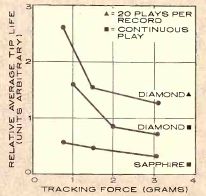
Figure 2. The average lives for diamond and sapphire tips under different
playing conditions are compared. Tip lives, given in arbitrary instead of
absolute units, are for comparison only.
Records were wiped with a dry, velvet-plush pad. Tips were cleaned with a brush moistened with a solution of ethyl alcohol and distilled water. The skating compensation was adjusted to the changer's recommended setting for a given tracking force.
Based on photographs of the tips at high magnification, the results showed that decreasing the tracking force from 1.5 to 0.75 gram extended tip life by approximately 70 percent. Figure 2 is a graph of relative average tip life vs.
tracking force. This graph also illustrates the average difference in tip life between diamond tips when the same record is played continuously and when records are limited to twenty plays. Another curve shows the aver age relative difference in life between sapphire tips and natural diamond tips.
It is interesting to note that the wear rates of individual tips varied significantly, even with all of the precautions that were taken to conduct a controlled test-which illustrates the importance of testing a significant quantity of styli.
Possible variations among the records or differences in the crystalline structure of the diamonds were assumed to be responsible.
In another test, styli were evaluated as before, but without use of skating compensation. Because of the skating force, one would expect that the inner groove wall (the left channel) would be subjected to a higher force than the right channel. Results varied, but the average of the tips did exhibit more wear on the left-channel side. An ex ample of a spherical tip worn on one side because of the absence of skating compensation is shown in Figure 3.
Tests to investigate record wear have also been conducted. One procedure involved repeated playing of a test disc by a given stylus and measuring the increase iin second-harmonic distortion of a particular signal. In this case a top-quality stylus with a bi-radial tip played a record with a 6,000-Hz test signal at a given radius one hundred times at a tracking force of 1.5 grams. After one hundred plays the average distortion of both channels in creased by approximately one-third of the original value. However, the distortion was still not audibly apparent.
Again, variation among individual styli and records was significant, possibly because of slight differences in tip shape and dimensions, or of variations among the records.
Another consideration when record damage is examined is the amount of time allowed for recovery of the de formed vinyl. In our tests, distortion levels were inconsistent when several minutes of rest were allowed after several consecutive plays of a given signal. Although rather firm statements have been made on the matter, not enough data are available at this time to determine whether repeated plays of a given groove area in a brief period of time significantly shorten record life.
Tests were also conducted to ob serve the difference in record damage between groove modulation that was tracked and modulation that was mis tracked because of cartridge inadequacies. For this test V-IS Type III and the older V-15 (Type I) styli played the musical bells selection on Shure's "Audio Obstacle Course-Era III" test discs.
The styli had bi-radial tips of the same size, and they were tested on the same turntable and tone arm. Listening to the selection as it was played by each type of stylus revealed that the V-15 Type III cleanly tracked the entire se lection, but the V-15 (Type I) mis tracked several passages. The records, which were new and examined prior to the first play, were re-examined fol lowing the tenth play. Figure 4 (page 56) shows the right-channel groove wall of a record played by a V-15 Type III and one played by a V-15 (Type 1).
The V-15 (Type 1) had severely mis tracked this region of the groove, inflicting considerable damage as the tip literally bounced along the groove wall. The record played by the V-I5 Type III had not been, significantly modified.
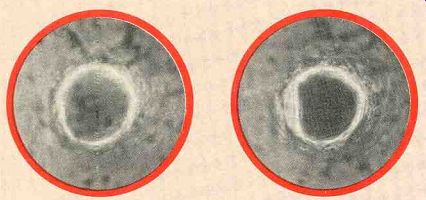
Figure 3. The two 9.7-tail styli shown have been subjected to equal use,
but the one on the left was used with properly adjusted skating compensation,
the one on the right not.
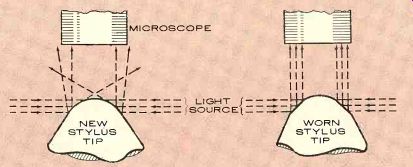
Figure
5. When a stylus is illuminated under the microscope by a light source pinging
from all sides, light is reflected toward the microscope's objective lens.
The rounded contours of the unworn stylus (left) diffuse the light. However,
the 45-degree "flats" of a worn stylus (right) reflect light directly
into the lens.
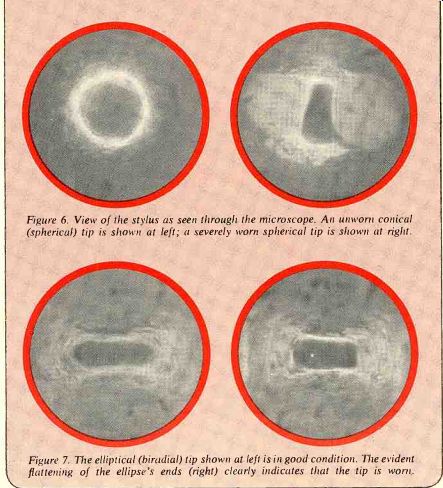
Figure 6. View of the stylus as seen through the microscope. An unworn conical
(spherical) tip is shown at left: a severely worn spherical tip is shown at
right.
Figure 7. The elliptical (hi-radial) tip shown at left is in good condition. The evident flattening of the ellipse's ends (right) clearly indicates that the tip is worn.
------------
Also see:
UNDERSTANDING RECORD PLAYERS: What you should know before you go out shopping, JULIAN D. HIRSCH
In the Groove: Close-Up View of Record Wear (Audio, Sept. 1980)
EQUIPMENT TEST REPORTS--Hirsch-Houck Laboratory test results on: the Akai GXC-325D stereo cassette deck, Stax SR-5 stereo headphones, Design Acoustics D-2 speaker system, and Lenco L-85 turntable, JULIAN D. HIRSCH